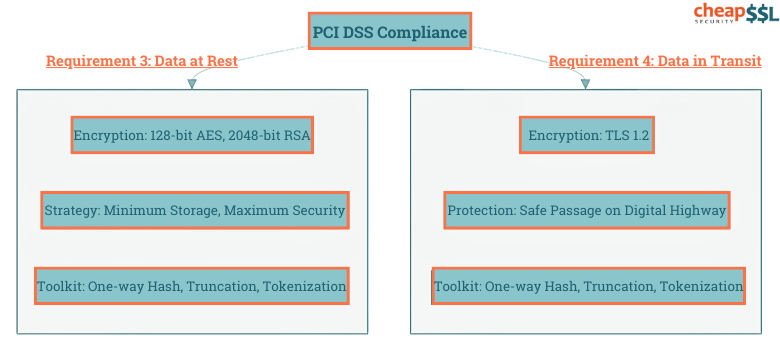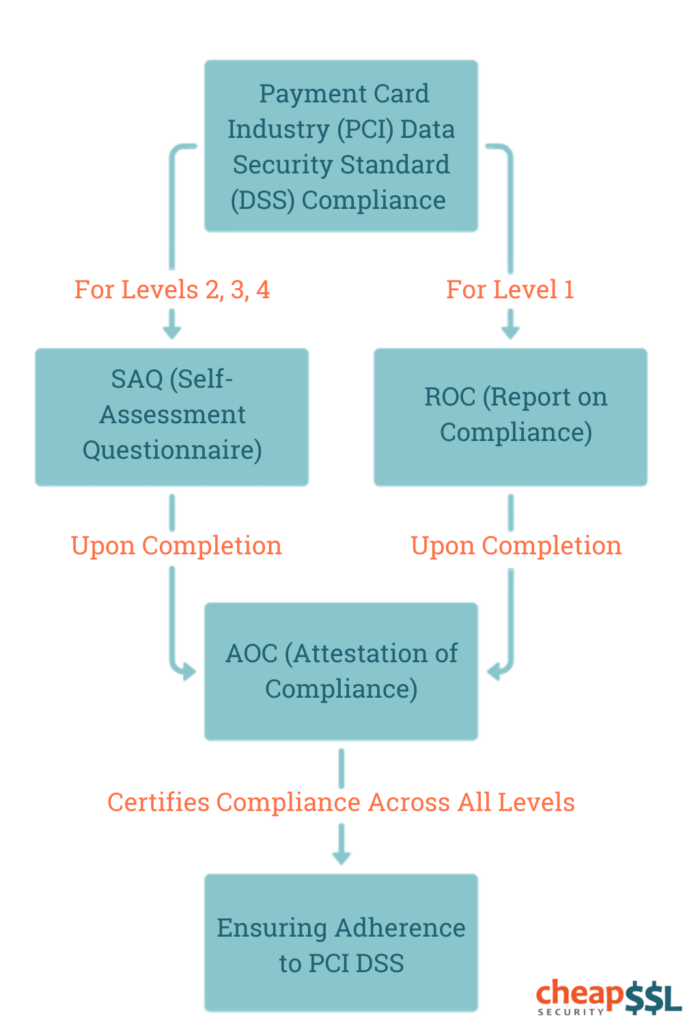92% of surveyed consumers believe most companies prioritize profits over their data’s security. Prove that your business isn’t one of them by achieving PCI DSS compliance.
Getting (Payment Card Industry Data Security Standard (PCI DSS) certification might seem challenging, especially if your business swipes credit and debit cards all day long. But trust us, this step is crucial for building and maintaining customer trust.
Five reasons to consider PCI DSS compliance for your business:
- PCI DSS provides a robust framework that protects against hackers.
- The certification ensures your customers’ payment data is secure and helps you avoid non-compliance fines and penalties.
- Compliance demonstrates your commitment to security and building trust with customers and partners.
- PCI DSS can be customized to fit your specific business needs, ensuring comprehensive protection.
- The process promotes the ongoing enhancement of your security measures.
Our article gives you a straightforward checklist and a step-by-step guide to getting PCI DSS certified. We make it simple, ensuring you have everything you need to uphold high payment security standards.
After all this, are you curious to learn more about PCI DSS compliance for your business? Let’s get started.
What Is PCI DSS Certification? A Quick Overview
PCI DSS is the gold standard for payment card security. It’s a set of industry standards that helps businesses like yours keep customer payment information safe from cyber threats. PCI DSS compliance isn’t just a badge of honor; it’s an example of your commitment to protecting the very heart of your customer relationships: their trust and data security.
When we discuss the importance of becoming PCI DSS compliant, it’s essential to understand that it’s like putting on your best suit of armor. This certification isn’t just about ticking off a PCI compliance requirement checklist; rather, it’s about building a strong security foundation for every payment card transaction.
What Having PCI Compliance Certification Says About Your Business
Achieving PCI compliance certification demonstrates that you’re taking proactive measures to fortify your business and customer data against data breaches. It shows your customers and partners that you’re committed to protecting their sensitive information. It’s a powerful statement in today’s world of online shopping, and it can go a long way in building trust and credibility with your customers and other stakeholders.
How to Get a PCI DSS Compliance Certification (In 6 Steps)
In the context of PCI DSS, we’re talking about a standard forged by the collaboration of major credit card giants: Visa, Mastercard, American Express, Discover Financial Services, and JCB International. This standard, evolving through versions like the comprehensive PCI DSS 4.0 of 2022, reflects the ongoing commitment to transaction security in an age where payment methods are as diverse as the marketplace itself.
PCI DSS 4.0 officially took effect on April 1, 2024, retiring PCI DSS version 3.2.1. However, additional requirements will take effect on March 31, 2025. The latest version, PCI DSS version 4.0.1, was released in June 2024 and amends some of the requirements. It doesn’t add or remove any of the new requirements from version 4.0.
As we approach the six steps to PCI DSS certification, remember that this is about aligning with a framework designed by the titans of the credit card industry. It’s a strategic move to align your business with the PCI DSS best practices in payment card security, a key step for anyone in the ever-changing world of electronic transactions.
Step 1: Determine Your PCI DSS Compliance Scope and Level
Kicking off your journey to PCI DSS compliance begins with a crucial first step: figuring out your business’s specific scope and level within the PCI DSS framework. Think of it as drawing your own map in the vast world of credit card transactions. You pinpoint exactly where and how your business interacts with credit card data. Understanding your scope is important, whether through an online platform or a physical point-of-sale system.
Next, you must determine your PCI DSS level. This is where things get a bit more specific. The levels are based on how many credit card transactions your business handles annually:
- Level 1: For the high rollers processing over 6 million transactions.
- Level 2: This is you, if you’re handling between 1 and 6 million transactions.
- Level 3: This is for businesses that handle 20,000 to 1 million transactions.
- Level 4: And for the smaller scale operations with fewer than 20,000 e-commerce transactions.

Image caption: PCI DSS compliance levels based on merchant transaction volumes.
Remember, each level has its own set of requirements and steps towards compliance.
- Level 1 businesses, for example, need a thorough on-site audit by a third party.
- Meanwhile, Levels 2-4 can be self-assessed with a questionnaire (self-assessment questionnaires [SAQs] are discussed later in the article).
This step isn’t just a formality; it’s about tailoring the compliance process to fit your business’s size and transaction volume, ensuring you cover all the bases in securing cardholder data.
In essence, this first step is all about self-awareness. It’s understanding where your business stands in the grand scheme of PCI DSS and setting the stage for the specific actions you’ll need to take. Once you’ve got a clear picture of your scope and level, you’re well on your way to navigating the rest of the PCI DSS compliance process.
Step 2: Understand and Prioritize Implementing the 12 PCI DSS Requirements
Step two is like piecing together a puzzle that guards your customer’s credit card info. The 12 requirements form a set of security guidelines created by the Payment Card Industry Security Standards Council (PCI SSC). The council’s goal is to ensure that all companies handling credit card information maintain a secure environment throughout the process of accepting, processing, storing, or transmitting such information.
These 12 PCI DSS principal requirements aren’t just rules but smart strategies to keep customer data under lock and key.
| The 12 Principal PCI DSS Requirements | ||
| PCI DSS Requirements Security Standard | Explanation | |
| Build and Maintain a Secure Network and Systems | 1. Install and Maintain Network Security Controls | Establish a comprehensive firewall.Implement intrusion detection and prevention systems (IDPS).Regularly update firewall and IDPS rules. |
| 2. Apply Secure Configurations to All System Components | Avoid using default vendor passwords.Harden operating systems and applications.Implement least privilege principles and disable unnecessary services. | |
| Protect Account Data | 3. Protect Stored Account Data | Encrypt sensitive data at rest.Implement access controls and logging.Perform regular audits of data storage practices. |
| 4. Protect Cardholder Data with Strong Cryptography During Transmission Over Open, Public Networks | Use strong encryption protocols like TLS 1.2 or higher.Implement VPNs for secure remote access.Regularly update cryptographic keys and certificates. | |
| Maintain a Vulnerability Management Program | 5. Protect All Systems and Networks From Malicious Software | Deploy and maintain anti-virus and anti-malware solutions.Implement endpoint detection and response (EDR) tools.Conduct regular threat intelligence updates and patch management. |
| 6. Develop and Maintain Secure Systems and Software | Follow secure coding practices.Conduct regular security testing, including vulnerability assessments and penetration tests.Maintain an updated inventory of systems and software. | |
| Implement Strong Access Control Measures | 7. Restrict Access to System Components and Cardholder Data by Business Need to Know | Implement role-based access control (RBAC).Conduct regular access reviews and audits.Use multi-factor authentication (MFA) for critical systems. |
| 8. Identify Users and Authenticate Access to System Components | Assign unique IDs to each user.Implement identity and access management (IAM) solutions.Monitor and log user activities for anomalies. | |
| 9. Restrict Physical Access to Cardholder Data. | Implement physical access controls, such as biometrics and smart cards.Use surveillance cameras and security guards to monitor access points.Maintain detailed logs of physical access events. | |
| Regularly Monitor and Test Networks | 10. Log and Monitor All Access to System Components and Cardholder Data | Employ security information and event management (SIEM) systems.Correlate logs from different sources for comprehensive monitoring.Conduct regular audits and reviews of access logs. |
| 11. Test Security of Systems and Networks Regularly | Perform regular vulnerability scans and penetration tests.Conduct security assessments and audits.Implement continuous monitoring and improvement processes. | |
| Maintain an Information Security Policy | 12. Support Information Security with Organizational Policies and Programs | Develop a comprehensive information security policy.Conduct regular security awareness training for staff.Establish incident response and disaster recovery plans. |
Each of these requirements is a critical piece in building a secure environment for credit card transactions. They work together to form a shield around your customer’s data, ensuring their trust in your business remains solid. Let’s view these PCI DSS standards as requirements plus valuable tools that empower your business in digital payments.
A great way to get started with these requirements is to run a PCI Compliance Scan.
Step 3: Team Up With a Network Security Expert
If tech isn’t your strong suit, bring in an IT professional. This move is pivotal, as they handle the complexities of network security and firewall management, acting as your business’s data watchdog. An IT network security expert is a part of your frontline defense, constantly on the lookout for vulnerabilities and ensuring your online transactions are secure.
To provide security to your network, take note of the following points:
- Apply continuous network monitoring for uninterrupted security: Implement a system that continuously monitors your network for potential breaches or suspicious activities.
- Carry out regular penetration testing and vulnerability scans: These essential tools keep your defenses up to date. Tailored to your business’s unique needs, they help maintain sharp, resilient security measures.
- Perform routine security reviews and testing: Regular health checks for your network are crucial. An annual review with additional checks following unusual activities keeps your security measures agile and responsive.
- Execute stringent firewall management: Continuously nurture and update firewalls, your first line of defense, to protect your network effectively. While firewalls were introduced in Step 2, it’s important to emphasize their ongoing management and updating here, under the guidance of your tech expert.
- Implement a robust password strategy: Regularly update complex passwords to secure your network. This echoes the password strategies mentioned in Step 2 but highlights their continuous management and enforcement as a critical ongoing practice.
This strategic partnership with a tech expert transforms your network into a secure, resilient operation, instilling trust and reliability that enhances customer relationships.
Step 4: Put Encryption at the Heart of Your PCI DSS Compliance
Data is as valuable as gold, and there’s no compromise when it comes to protecting payment information. PCI DSS certification requirements 3 and 4 are at the core of this mission, providing a clear framework for encrypting data both stored and in transit.
- Provide a safe haven for data at rest: Requirement 3 is about turning sensitive card details into an unreadable code that only authorized eyes can decipher. Employing symmetric encryption and hashing algorithms (such as 128-bit AES and 2048-bit RSA) ensures these numbers stay confidential. It’s a strategy that embraces minimum storage and maximum security, storing only what’s essential and locking it down tight.
- Ensure safe passage for data in transit: Think of Requirement 4 as the armored transport for data on the digital highway. It dictates that as cardholder data moves across the internet, it must travel under the cloak of robust public key encryption protocols like TLS 1.2, keeping it hidden from cyber predators.
- Bolster your defenses by building your encryption toolkit: To meet these standards, your toolkit might include one-way hash functions that scramble data beyond recognition, truncation methods that cut data down to size, and tokenization techniques that swap out sensitive details for harmless placeholders.

Image caption: PCI DSS compliance: encryption standards overview for data at rest and in transit.
- Encourage an encryption-always mindset: With 80% of companies storing sensitive data in the cloud, securing this data is more critical than ever. Adopting these encryption practices means embedding a culture of security within your organization. It’s about proactive vigilance, regular security updates, and an unwavering commitment to protect the trust your customers place in you with every swipe, tap, or click.
Commit to Robust, Encryption-Based Security
Want to demonstrate your commitment to data protection? Choose our Organization Validation SSL/TLS Certificates for superior transaction security.
Step 5: Complete the PCI DSS Compliance Paper Trail
Step five of your PCI DSS certification process is all about getting your paperwork in order. Think of this step as the “homework” phase — it’s time to show your work and prove that your business is up to par with PCI standards.
Self-Assessment for Small Businesses – SAQ
If your business is a small operation (hello, Level 2 and 3 merchants!), you will become best friends with the Self-Assessment Questionnaire. It’s like taking a quiz where you confirm that you’ve done your security homework. This questionnaire, which now has nine variations (as of PCI DSS 4.0) based on your organization size and other specific factors, aligns with the PCI DSS requirements and helps you attest to the security measures you’ve implemented.
Filling out the SAQ might seem daunting, but it’s really about ticking the boxes to show you’re on top of your security game. You’ll also need to gather specific supporting documents to demonstrate compliance. The key supporting documents typically include:
- Policies and procedures for data retention and protection of stored account data (e.g., receipts, paper reports).
- Records of security vulnerability management.
- Access control policies.
- Audit logs and reviews.
- Incident response plans.
And if you’re a bit lost on which questionnaire to use, no sweat — your payment card vendor or acquiring bank can point you in the right direction.
Level 4 merchants, you’re not off the hook completely. It’s recommended (though not mandatory) that you complete the SAQ, too. Consider it a best practice to keep your business secure and customer trust high.
Professional Audits for Large Businesses – ROC
Now, the audit process is a bit more involved for the “heavy hitters” (looking at you, Level 1 merchants). You need to bring in a Payment Card Industry Qualified Security Assessor (PCI QSA). These individuals are the cybersecurity wizards who are explicitly trained to conduct an audit to ensure your business meets all the required security standards.
Think of the PCI QSA as your personal cybersecurity inspector. They’ll go through your operations with a fine-tooth comb, ensuring every nook and cranny of your business is secure. After the audit, they’ll complete an annual Report on Compliance (ROC). This report is essentially your cybersecurity report card, showing that you’ve met all the necessary criteria for the year.
NOTE: An ROC is mandatory only for Level 1 merchants, while merchants in Levels 2, 3, and 4 typically use the SAQ for compliance validation.
Attestation of Compliance for All – AOC
Once you’ve completed the SAQ or ROC, the next step is the Attestation of Compliance (AOC). Think of this as your official stamp of approval. The form says, “Yes, we did the checks, and yes, we’re up to snuff.” This attestation includes your completed SAQ or ROC and backs up your claim of being PCI compliant.
Wondering whether you need to complete an AOC? Every business that falls under the umbrella of PCI DSS, regardless of its transaction volume, needs an AOC. It’s a universal requirement across all PCI levels, underscoring the importance of maintaining stringent security protocols. Think of the AOC as your personalized security badge, showing you play by the rules set by the big credit card companies. It’s like having a seal of approval on your business PCI DSS best practices, showcasing your dedication to protecting customer data.
This certification isn’t just a one-and-done affair; it carries a time frame. The moment you receive your QSA-issued AOC marks the start of your compliance period, which typically lasts one year from the date the AOC is signed.
Clarifying Compliance Documents in PCI DSS
Let’s simplify this a little more:
- The SAQ is primarily for smaller merchants (Levels 2, 3, and 4) to self-evaluate their compliance.
- The comprehensive ROC is necessary for Level 1 merchants and must be completed by a QSA.
- The AOC works alongside the SAQ or ROC, certifying the organization’s adherence to PCI standards.

Image caption: PCI DSS compliance flow from SAQ and ROC to universal AOC certification.
Achieve PCI DSS Compliance with Confidence
Ready to safeguard your customer data? Use HackerGuardian PCI Scan Control Center for robust PCI DSS compliance.
Step 6: Help Your Team Level Up Their Cybersecurity Skills
In 2023, the global average data breach cost soared to an all-time high of $4.45 million, marking a 15% increase over the past three years. This startling statistic underscores the critical role of employee training in the PCI DSS certification process.
Far from being just another task, training your staff transforms them from potential security vulnerabilities into your most robust line of defense.
- Provide custom-fit training to meet employees’ roles: One size does not fit all in security training. Different roles require different training. A front-desk officer’s security needs differ from those of an operational manager. Customized programs ensure that employees understand their specific role in protecting cardholder data. By zeroing in on role-specific training, you’re ensuring everyone gets the info they need, nothing more, nothing less.
- Keep the training wheels turning via ongoing education: Security training isn’t a one-off event; it’s a continuous process. Regular updates are crucial to inform staff of the latest threats and adhere to PCI DSS best practices. It’s recommended that training should be held monthly rather than annually, as repetition aids retention and keeps security top of mind for everyone.
- Enable critical data handlers to get CASP+ certification: A certification like CASP+ can be invaluable for employees handling critical data. It ensures they’re equipped to understand, retain, and apply PCI DSS procedure steps effectively.
- Ensure your training and education are robust and cover all bases: Security training isn’t just about memorizing passwords. It’s about understanding the full spectrum of threats and data security concerns — from phishing scams to the nitty-gritty of data classifications. Your team will be better prepared to spot and stop security threats with more topics you cover.
- Encourage a ‘Speak up, stay safe’ organizational culture: An effective training program also includes elements of accountability and reporting. Employees should be encouraged to flag any suspicious activities promptly and understand their role in maintaining compliance. Establishing a non-punitive culture for reporting helps in mitigating risks quickly and effectively.
Hence, empowering your team with the proper knowledge and tools isn’t just a checkbox for compliance. It’s about building a workplace culture that breathes security, where every employee plays a crucial role in protecting your customer’s data. It’s not just good for compliance; it’s great for business.
Evaluate the Cost of Ignoring PCI Standards
Ignoring PCI requirements can lead your business down a perilous (and costly) path. Beyond the risks of devastating data breaches, non-compliance can attract adverse publicity and result in severe business consequences. These can include one or all of the following:
- Penalties ranging from $5,000 to $10,000 monthly (enforced by the credit card companies, banks, and process servers, not the PCI Security Standards Council)
- Loss of banking and payment processor relationships
- Removal from a bank’s service provider registry (e.g., Visa’s Global Registry of Service Providers)
- Increased transaction fees
- Reputational damages
- Loss of customer relationships, trust, and revenue opportunities
These consequences can be dire for small businesses, potentially leading to closure. A strategic move would be to ensure your business remains a trusted and viable player in the digital marketplace.
Why You Should Prioritize PCI DSS Compliance
Investing in privacy isn’t just a defensive strategy; it’s a move that can pay off in customer loyalty and bottom-line gains.
- A whopping 63% of consumers worldwide doubt companies are truthful about using their data, and nearly half have stopped buying from businesses due to privacy concerns. Concerning consumer worries, financial and banking information tops the chart at 78%.
- 81% of users perceive how a company handles their data as reflective of their value as customers.
- In the US, an overwhelming 90% of internet users agree that online privacy is crucial, emphasizing the need for businesses to prioritize data security in their operations.
As you can see, PCI compliance isn’t just a regulatory hoop to jump through. It’s a trust-building exercise that demonstrates your commitment to protecting your customers’ sensitive payment card data.
Build Software Trust with Code Signing
Strengthen trust in your software and aid PCI DSS compliance by signing a Software Bill of Trust (SBOM) with a Code Signing Certificate.
Final Thoughts on Achieving a PCI DSS Certification for Your Business
Achieving PCI DSS certification is more than just meeting regulatory requirements. So, what perks does PCI DSS certification bring to your company?
- Builds trust with your customers: Certification demonstrates your commitment to data security, reassuring your customers about the safety of their information.
- Helps you stay secure with robust measures: Implementing the 12 PCI DSS requirements protects your data against digital threats and data breaches.
- Provides continuous effort to achieve resilience: Ongoing compliance efforts ensure that you keep up with evolving security challenges and maintain robust protection measures.
In the end, PCI DSS certification is more than a badge. Did you know that 70% of professionals report significant benefits from improving data privacy? For every business, big or small, it’s critical to keep security measures up to date and adapt to new threats. It’s a commitment to continuous improvement in data security, giving peace of mind to every customer who trusts you with their information.






